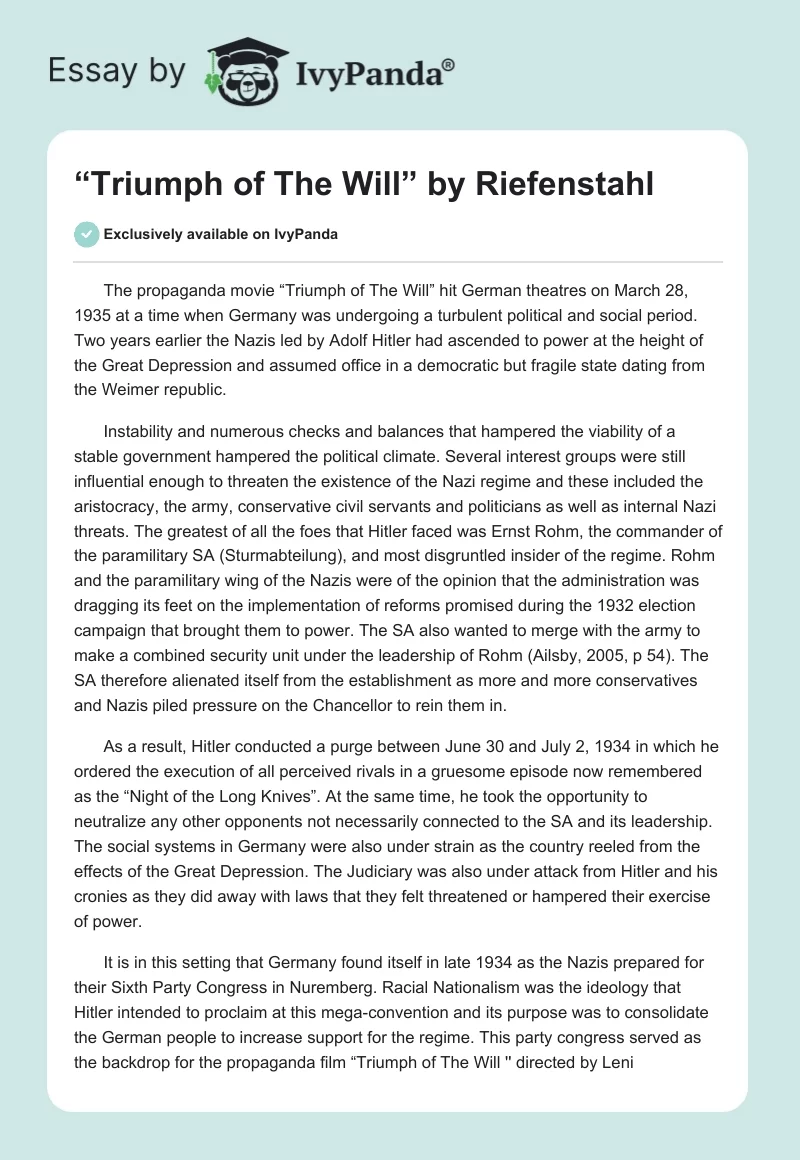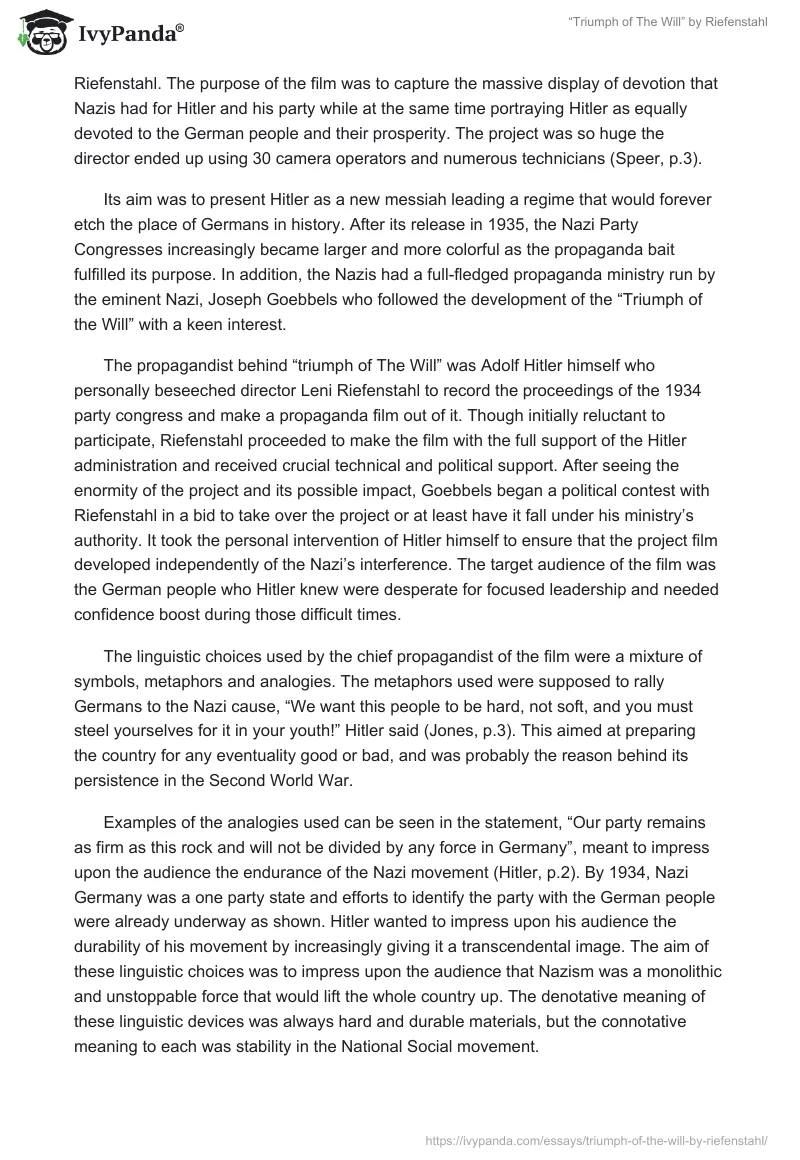The propaganda movie “Triumph of The Will” hit German theatres on March 28, 1935 at a time when Germany was undergoing a turbulent political and social period. Two years earlier the Nazis led by Adolf Hitler had ascended to power at the height of the Great Depression and assumed office in a democratic but fragile state dating from the Weimer republic.
Instability and numerous checks and balances that hampered the viability of a stable government hampered the political climate. Several interest groups were still influential enough to threaten the existence of the Nazi regime and these included the aristocracy, the army, conservative civil servants and politicians as well as internal Nazi threats. The greatest of all the foes that Hitler faced was Ernst Rohm, the commander of the paramilitary SA (Sturmabteilung), and most disgruntled insider of the regime. Rohm and the paramilitary wing of the Nazis were of the opinion that the administration was dragging its feet on the implementation of reforms promised during the 1932 election campaign that brought them to power. The SA also wanted to merge with the army to make a combined security unit under the leadership of Rohm (Ailsby, 2005, p 54). The SA therefore alienated itself from the establishment as more and more conservatives and Nazis piled pressure on the Chancellor to rein them in.
As a result, Hitler conducted a purge between June 30 and July 2, 1934 in which he ordered the execution of all perceived rivals in a gruesome episode now remembered as the “Night of the Long Knives”. At the same time, he took the opportunity to neutralize any other opponents not necessarily connected to the SA and its leadership. The social systems in Germany were also under strain as the country reeled from the effects of the Great Depression. The Judiciary was also under attack from Hitler and his cronies as they did away with laws that they felt threatened or hampered their exercise of power.
It is in this setting that Germany found itself in late 1934 as the Nazis prepared for their Sixth Party Congress in Nuremberg. Racial Nationalism was the ideology that Hitler intended to proclaim at this mega-convention and its purpose was to consolidate the German people to increase support for the regime. This party congress served as the backdrop for the propaganda film “Triumph of The Will ” directed by Leni Riefenstahl. The purpose of the film was to capture the massive display of devotion that Nazis had for Hitler and his party while at the same time portraying Hitler as equally devoted to the German people and their prosperity. The project was so huge the director ended up using 30 camera operators and numerous technicians (Speer, p.3).
Its aim was to present Hitler as a new messiah leading a regime that would forever etch the place of Germans in history. After its release in 1935, the Nazi Party Congresses increasingly became larger and more colorful as the propaganda bait fulfilled its purpose. In addition, the Nazis had a full-fledged propaganda ministry run by the eminent Nazi, Joseph Goebbels who followed the development of the “Triumph of the Will” with a keen interest.
The propagandist behind “triumph of The Will” was Adolf Hitler himself who personally beseeched director Leni Riefenstahl to record the proceedings of the 1934 party congress and make a propaganda film out of it. Though initially reluctant to participate, Riefenstahl proceeded to make the film with the full support of the Hitler administration and received crucial technical and political support. After seeing the enormity of the project and its possible impact, Goebbels began a political contest with Riefenstahl in a bid to take over the project or at least have it fall under his ministry’s authority. It took the personal intervention of Hitler himself to ensure that the project film developed independently of the Nazi’s interference. The target audience of the film was the German people who Hitler knew were desperate for focused leadership and needed confidence boost during those difficult times.
The linguistic choices used by the chief propagandist of the film were a mixture of symbols, metaphors and analogies. The metaphors used were supposed to rally Germans to the Nazi cause, “We want this people to be hard, not soft, and you must steel yourselves for it in your youth!” Hitler said (Jones, p.3). This aimed at preparing the country for any eventuality good or bad, and was probably the reason behind its persistence in the Second World War.
Examples of the analogies used can be seen in the statement, “Our party remains as firm as this rock and will not be divided by any force in Germany”, meant to impress upon the audience the endurance of the Nazi movement (Hitler, p.2). By 1934, Nazi Germany was a one party state and efforts to identify the party with the German people were already underway as shown. Hitler wanted to impress upon his audience the durability of his movement by increasingly giving it a transcendental image. The aim of these linguistic choices was to impress upon the audience that Nazism was a monolithic and unstoppable force that would lift the whole country up. The denotative meaning of these linguistic devices was always hard and durable materials, but the connotative meaning to each was stability in the National Social movement.
The visual choice most used by the propagandist was animation as Kelman explains, “That is the imparting of spirit or life to matter, is achieved by close-up and angle of vision” (2003, p.3). “Most remarkable here is the episode of flags parading, in which there are the merest glimpses of those bearing them … Close-up plunges the viewer into the midst of flags that seem to move by themselves … “reality” becomes figurative, things move as if charged with supernatural power, with a will of their own, or more precisely, the will of Hitler” (Kelman, p.3). The Nazis were keen to fill the minds of Germans with an almost religious devotion to the party and its schemes. It is this that inspired the use of animation, to convey a subliminal impression that “Hitler the messiah” was leading a change in the German way of life at the service of a greater cause.
There was an even deeper meaning hidden in the film, “…the basic images or motifs are varied, orchestrated. These motifs are: ancient things (buildings, statues, icons); the sky; clouds (or smoke); fire; the swastika; marching; the masses; Hitler … The central theme which they develop is that Hitler has come from the sky to kindle ancient Nuremberg with primal Teutonic fire, to liberate the energy and spirit of the German people through a dynamic new movement with roots deep in their racial consciousness” (Kelman, 2003, p.2). This dizzying combination of symbols and sounds combined to enthrall the audience at a time when filmmaking was very rudimentary.
In addition to these devices, Riefenstahl applied her own techniques to contribute her share of propagandist efforts. The other visual techniques included transfiguration of ordinary people to mindless souls through camera angling and the exultation of Hitler to a god amongst men through varied focus.
In his speech, Hitler made deliberate attempts to sweep the audience into frenzy through his words. His deliberate pauses, voice intonations, shouts and silences aimed at creating an awe-inspiring effect on the audience, you just had to stop and pay attention. There was no chance of getting bored or falling asleep as the audience stopped to cheer every few minutes (Hitler, Triumph of the Will, 1935).
The objective of these propaganda techniques was to impress upon Germans the key principle of National Socialism; racial nationalism. To do this the Nazis had to make Germans view themselves as a dignified and supreme people, then convince them that they must unite to succeed and finally, pinpoint a common enemy to unite against.
The Triumph of The Will was also a clear attempt at manipulating the audience’s emotions to achieve predetermined goals. The intention was to arouse sympathy for the Nazi cause and euphoria at its immensity and pervasiveness. Judging from the behavior of ordinary Germans before and during the Second World War, the film achieved its goals.
At the same time, the expectation was for the best of Germans to be automatic Nazis or at least to identify with Nazism. This requirement often came through the peripheral route, with a great dose of vagueness. Simple Germans had to assimilate Nazism and its tenets without question and the propaganda ministry was always on-hand to ensure this was happening. The metaphors, symbols and analogies used throughout the film simply inspired deep Nazism without rational explanations.
It is these same messages that Adolf Hitler repeated at the Nuremberg party conference and on numerous subsequent occasions. Sometimes it was done forcefully, but most of the time he used constant persuasion and repetition to hammer in his message. The result was an increasingly fanatical country in which a Holocaust against the Jews took place without much protest from the working class or intelligentsia.
In conclusion, Triumph of the Will is one of the best propaganda films in history. The lingering question that hasn’t been answered to date is whether Riefenstahl knew that she was facilitating propaganda or being a propagandist, as Kelman says, “Fair enough, it’s now scientific commonplace that the act of observation changes the thing observed … Riefenstahl was then in the position of observing over and over her original response, the effect she recorded, Could she then not have recognized it as serving the purpose of propaganda?” (Kelman, 2003, p.7). Ms Riefenstahl took the answer for this question to her grave when she passed away in 2003.
The intended effect of The Triumph of the Will was definitely achieved but with devastating consequences for Germany and the rest of the world.
Works cited
Ailsby, Christopher. The Third Reich Day By Day. Minnesota: Zenith Imprint, 2005.
Hitler, Adolf. Triumph des Willens Quote. 2011. Web.
Jones, Julie. Professor Julie Jones’ Course Website. 2011. Web.
Kelman, Ken. “On Leni Riefenstahl and Triumph of the Will.” Logos Journal (2003): 3.
Speer, Albert. Architectural direction of the Nuremberg Rally. 2011.
Triumph of the Will. Dir. Leni Riefenstahl. Perf. Adolf Hitler. 1935.
Wheeler-Bennett, John. The Nemesis of Power: The German Army in Politics 1918–1945. Palgrave Macmillan, 2005.


